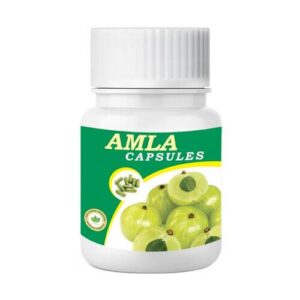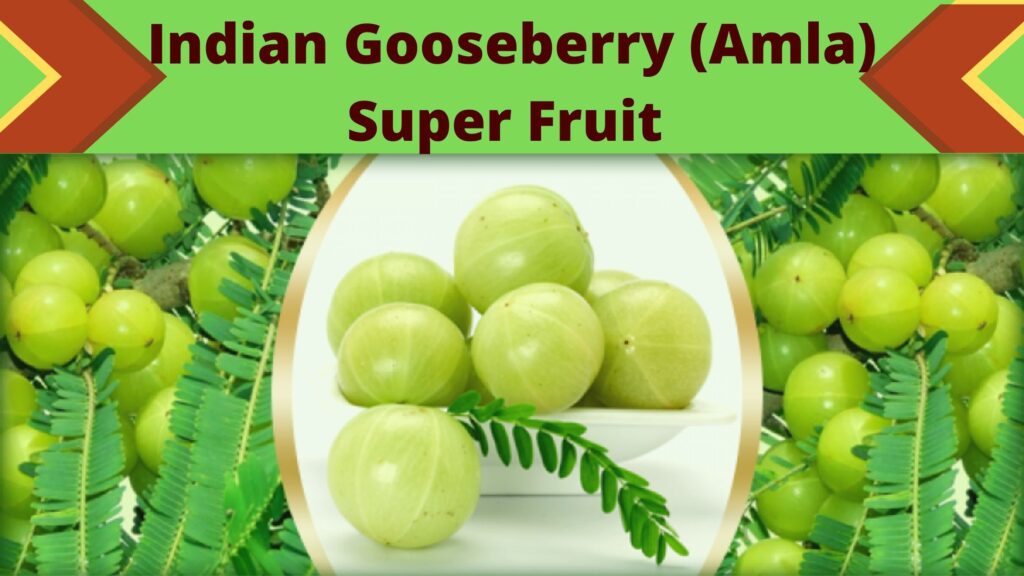Amla Indian Gooseberry Benefits
Introduction: Amla in Ayurveda is known as ‘Amalaki’. In common terms, Amla Indian Gooseberry, that has long been revered in India as the best blood purifier, nutritive tonic, and restorative mucous membrane tonic.
Indian Gooseberry (Amla) has five of the six tastes (sour, bitter, pungent, astringent, sweet), although, sour is its main taste. Amla is considered cooling in action, and it is widely used to balance the aggravated Pitta dosha and support normal ranges of blood sugar, build blood, support liver function, respiratory system, etc.
It is considered the “Mother” because it performs the job of taking total care of the nervous and all body system and is known as the ultimate healer due to its immune restorative properties. In Charak Samhita Amla is well known as Rasayana and is revered as one of the most potent and nourishing herbs which supports longevity.
Different names of Amla Indian Gooseberry:
- Botanical name: Phyllanthus emblica
- English name: Indian Gooseberry
- Hindi name: Amla, Amwala
- Arabic: Halilaj
- Indonesia: Balakka
- Urdu name: Aamla, amal khushk
- Bengali: Amloki
- Chinese: Anmole
- Kannda: Bettada neilkkayi
- Malaysia: Melaka
- Malyalam: Neilli
- Marathi: Avala
- Punjabi: Aula
Synonymous of Amla:
त्रिष्वामलकमाख्यातं धािी त्रतष्यफलाऽमृता |
हरीतकीसमं धािीफलं त्रकन्तुत्रिशेषतः |
रक्तत्रित्तप्रमेहघ्नं िरं िृष्यं रसायनम्||३६||
हन्तन्त िातं तदम्लत्वान्तित्तं माधुययशैत्यतः |
कफं रूक्षकषायत्वात्फलं धात्र्यान्तिदोषत्रित्||३७||
यस्य यस्य फलस्येह िीयंभित्रत यादृशम्|
तस्य तस्यैि िीयेण मज्जानमत्रि त्रनत्रदयशेत्||३८||
(Bhavprakash Haritkyiadi varga) (37-41)
Common synonymous of Amla Indian Gooseberry is:
- Amrutaphala: That ensures longevity for the human being
- Vayasya: Rejuvenate the body
- Amalaki: That helps to retain (dharana) health due to its Rasayana property
- Dhatriphala
- Shriphala
Classification of Amla Indian Gooseberry:
- Kingdom: Plantae
- Division: Flowering plant
- Class: Magnoliopsida
- Order: Malpighiales
- Family: Phyllanthaceae
- Tribe: Phyllantheae
- Subtribe: Fluegginae
- Genus: Phyllanthus
- Species: P. emblica
- Zoological name: Phyllanthus emblica
Description of Amla Indian Gooseberry Plant:
India Gooseberry (Amla) is medium size deciduous plant and grows to a height of 10 -20 meters. Its flower is yellow-greenish and the fruit is spherical pale yellow with six vertical furrows. The weight of the fruit is approx 60 -70 gm. Its leaves are small, feathery, linear-oblong, and smell like lemon. Its wood is reddish and hard in texture.
Cultivation of Indian Gooseberry (Amla):
Amla can grow under tropical conditions, and in light as well as heavy soils. The plant requires proper sunlight and is generally propagated through seeds. It is planted through tropical India and is cultivated in Tamil Nadu, Rajasthan, Madhya Pradesh, Uttar Pradesh, etc.
Chemical composition of Amla:
The main active constituents of Indian Gooseberry (amla) are emblicanin A&B, Pedunculagin, Puniglucanin, 2-keto- gluconolactone. Other than this, amla fruit contains a high abundance of Ascorbic acid, tannins, gallic acid, albumin, cellulose, and other minerals. It contains carbohydrates 14.1 %, iron 1.2 mg, calcium 0.05 %, moisture 81.2 %, proteins 0.5%, fats 0.1 %, phosphorus 0.02 %, and nicotinic acid 0.2 mg per 100 grams.
Medicinal qualities of Amla:
- Guna (qualities): Heaviness (guru), and Coolant (sheeta)
- Rasa (taste): Amla contains sour, sweet, bitter, astringent, and pungent (all the five tastes, excluding salt)
- Vipaka: Sweet (madhra)
- Veerya (potency): Cold (sheeta)
- Dhatu: All dhatu (tissues) are affected specifically muscles and blood
- Effect on Tridosha: It balances Vata, Pitta, and Kapha dosha.
Parts used: Seeds and Fruits.
Karma of Amla Indian Gooseberry:
- Vrishya: Act as an aphrodisiac
- Kanthya: Useful in all throat diseases
- Raktapittaghna: Useful in bleeding disorders.
- Hrudya: Cardioprotective
- Daahahara: Relieves burning sensation
- Chakshushya: Help in improving the vision
- Jvarahara: Treat fever
- Rasayana: Act as anti-aging and rejuvenation
- Sarvadoshaghna: It balances Vata, Pitta and Kapha dosha
Balances Vata dosha due to its sour taste,
Pitta dosha due to its sweetness and coldness, and
Kapha dosha because amla has dryness and astringent properties.
Medicinal uses of Amla Indian Gooseberry according to the Ayurveda:
Indian Gooseberry (Amla) acts as anti-inflammatory, carminative, laxative, diuretic, astringent, antI-oxidative, hepatoprotective, anti-ulcer, an anti-cancer drug, etc. It works wonders in diabetes, asthma, bronchitis, anemia, jaundice, dyspepsia, hemorrhage disorders, etc. The multiple vitamins in Amla made it one of the most rejuvenating drugs which help to maintain proper health.
Amla Benefits:

- Provide strength to the Lungs: Amla is a wonderful fruit that provides proper nourishment to the lungs and entire respiratory tract. According to the Ayurveda, it pacifies Shleshama Kapha, which balances moisture in the lungs.
- Supports Liver: It helps to purify the Rasa Dhatu (nutrient fluid) and Rakta Dhatu (blood). It also regulates the proper secretion of hormones and supports the functioning of the liver, helping it in eliminates harmful toxins from the liver.
- Supports Heart functioning: In Ayurvedic texts, it is known as hridya, which means it provides nutrition to the heart and improves proper blood circulation.
- Improves digestion: Amla fruit improves the functioning of digestion, absorption, and assimilation of food. It improves a digestive fire (Agni) which prevents the formation of toxins in the body.
- Balances stomach acids: Amla is ideal for calming mild-to-moderate hyper acidity and other Pitta-related digestive problems. Alternatively, it improves appetite, balances the hormones, and overcomes the associated symptoms of pitta dosha.
- Enhances fertility: Amla provides nutrition to all the seven dhatus (body tissues) and balances the Apana Vata (a subtype of Vata dosha) thus supports the reproductive systems of both men and, women and can help to overcome a difficulty in conceiving. Due to its vrishya activity, it provides sufficient nutrients to the ovaries and sperm, and it has a property called garbhasthapana, which means it enhances the chances of fertility and the possibility of conception.
- Good for Skin: As amla supports the functioning of the liver, improves digestion and absorption of beneficial nutrients, eliminates the excess amount of toxins from the organs as well as from the blood, due to these properties it works wonders in cleanses the skin, improves complexion, supports the immunity of the skin against various infections. Amla enhances the glow and luster of the skin due to the presence of a high abundance of vitamin C.
- Eliminates harmful toxins: Amla fruit supports the liver in flushing out chemicals and additives from the physiology and maintains healthy digestion and strengthens the body’s immunity and protects it against seasonal cough and cold.
- Strengthens the eyes: Amla is also called ‘Chakshushya’, which means “strengthening the eyes”. Regular intake of amla improves the functioning of both Ranjaka Pitta (sub type of Pitta that governs liver function and the blood plasma) and Alochaka Pitta (that governs the eyes and vision).
- Regulate proper functioning of Urinary System: Amla fruit is a natural diuretic and eliminates harmful toxins through urination. It balances the function of Apana Vata thus protect the urinary system from various infections, and diseases.
- Amla for Hair growth: Vitamin C present in the amla help in maintaining the growth of hairs, prevents the scalp from dandruff, and other infections. It retards premature graying, and supports the strength of the hair follicles, make it smooth, shiny, and thicker.
Amla for Daily Basis:
- Amla churna: A person can mix 1/4 to 1/2 teaspoon into lukewarm water once or twice daily.
- Chyawanprasha: Another way to take Amla is through Chyawanprasha, which is an ayurvedic herbal jam made from a base of a high abundance of Amla combined with honey, ghee, sesame oil, berries, and spices. A person can take 1 to 2 teaspoons, once or twice daily.
- Triphala churna: Amla fruit is also one of three ingredients in Triphala, which is one of Ayurveda’s most popular herbs. A typical recommended dose is 500 to 1,000 milligrams, twice daily, or depends upon person the conditions.
Formulations:
- Amalaki churna
- Chyawanprasha
- Amalaki Rasayana
- Dhatri Lauha
- Dhatryadi Ghrita
- Triphala Churna
Matra:
- Churna: 3-6 g
- Fresh juice: 5 – 10 ml once daily
- Chyawanprasha: 1teaspoon once or twice.
Amla Indian Gooseberry Herbal Capsule from Deep Ayurveda’s Company:
 Amla Herbal Capsule: We made 100% extract-based capsules made from natural, pure, and genuine herbs. Amla herbal capsule is result-oriented because the formulation is prepared by an experienced Doctor and the capsule is launched after many clinical trials.
Amla Herbal Capsule: We made 100% extract-based capsules made from natural, pure, and genuine herbs. Amla herbal capsule is result-oriented because the formulation is prepared by an experienced Doctor and the capsule is launched after many clinical trials.
A person can take the Amla capsule as a supplement also that fulfills the nutrients in the body and prevent various seasonal infections. You can also use it as the core part of your diet and this capsule can take by every age of a person.
Regular intake of the Amla Herbal Capsule boosts immunity, removes the excess amount of toxins from the body, improves eyesight, skin, and nourishes the hairs, acts as anti-inflammatory, anti-oxidants, and provides multiple benefits to a person.
For more detail on Indian Gooseberry benefits, please visit our nearest clinic or if you want to consult with our Chief Ayurveda Consultant & Founder – Dr.Baldeep Kour then write with detailed history at info@deepayurveda.com
For regular health updates, please follow our Social Pages


